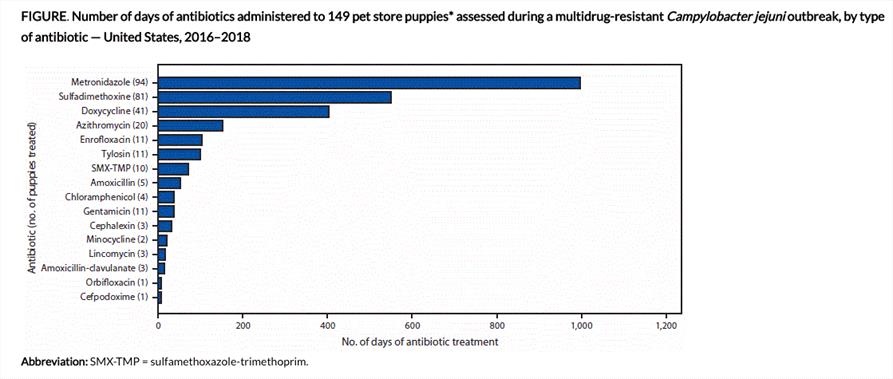 The September 21, 2018, edition of the CDC’s Morbidity and Mortality Weekly Report has a summary of the 2016-2018 campylobacterosis outbreak linked to pet store puppies. Nothing is particularly surprising, but that doesn’t mean it’s not disappointing (or depressing).
The September 21, 2018, edition of the CDC’s Morbidity and Mortality Weekly Report has a summary of the 2016-2018 campylobacterosis outbreak linked to pet store puppies. Nothing is particularly surprising, but that doesn’t mean it’s not disappointing (or depressing).
See the complete article. Here’s a (relatively) brief summary:
- It all started when sequencing of Campylobacter jejuni isolates identified the same Campylobacter strain from puppies from a commercial pet store chain in Florida and a person that bought a puppy from that chain in Ohio.
- Over the course of the investigation, 118 illnesses in people were identified, including 29 pet store employees. This is presumably only a minority of the actual infections that occurred, since most infections over the course of an outbreak go undiagnosed.
- Sick people were found in 18 states over slightly more than 2 years.
- No one died, but 24 percent of confirmed cases were hospitalized.
A particular concern was that the Campylobacter isolates were resistant to all commonly used antibiotics. This obviously complicates treatment because it means that initial treatments would likely fail, prolonging the course (and potentially severity) of disease.
The antibiotic resistance aspect is particularly frustrating. Investigators in four states visited pet stores and collected antibiotic use information. They obtained records for 149 puppies, and 142 of those had received one or more courses of antibiotics before arrival or at the store.
That’s ridiculous.
What’s even more ridiculous is the fact that 55 percent of treated puppies received drugs when they were not sick – the drugs were being used for “prevention.” Another 38 percent received antibiotics for both prevention and treatment. Only 1 percent of treated puppies were treated solely because they were actually sick.
If you need that much antibiotic treatment to truly prevent disease, you’re doing something very wrong. If you’re using that much antibiotic without any idea whether it’s needed or not, you’re also doing something wrong.
To me, that indicates:
- This approach to puppy breeding and selling is inappropriate on many levels.
- Antibiotic use practices for pet stores need to be developed (and followed).
- Veterinarians that dispense large volumes of drugs to pet stores need to be accountable for their use.
Hopefully this outbreak has been contained, but it’s far from certain. As the report says “Although the investigation is completed, the risk for multidrug-resistant Campylobacter transmission to employees and consumers continues.”
The article concludes with “Finally, antibiotics should only be administered under veterinary supervision with a valid veterinary-client-patient relationship, consistent with existing stewardship principles.” That’s very true, and while the majority of antibiotic use in companion animals is reasonable and the majority of vets care about antibiotic resistance and how they use antibiotics, there’s still a lot of room for improvement.

(reprinted with permission from Worms and Germs Blog)
2 Comments
Dawn Boothe
December 5, 2018
Anne Elizabeth Katherman
October 18, 2018